Geographic Information System Technology Combined with Back Propagation Neural Network in Groundwater Quality Monitoring
Abstract
:1. Introduction
2. Materials and Methods
2.1. Overview of GIS and Research Area
2.2. Analysis of the Temporal and Spatial Evolution of Water Chemical Types
2.3. Back Propagation Neural Network
2.4. Optimization of BPNN Based on the Number of Hidden Layer Nodes
2.5. WBPNN Based on the Groundwater Quality Prediction
2.6. Neural Network Training of Water Quality Level Prediction
3. Results
3.1. Statistical Results for Water Chemical Elements of Groundwater
3.2. Spatial Distribution of Groundwater Quality Based on the GIS
3.3. Analysis on Predicated Result of Water Quality Based on the BPNN
3.4. Water Quality Level Prediction and Spatial Distribution Based on BPNN
4. Discussion
5. Conclusions
Author Contributions
Funding
Conflicts of Interest
References
- Jiang, Q.; Wang, T.; Wang, Z.; Fu, Q.; Zhou, Z.; Zhao, Y.; Dong, Y. HHM- and RFRM-Based Water Resource System Risk Identification. Water Resour. Manag. 2018, 32, 4045–4061. [Google Scholar] [CrossRef]
- Kumar, P.; Johnson, B.A.; Dasgupta, R.; Avtar, R.; Chakraborty, S.; Kawai, M.; Magcale-Macandog, D.B. Participatory Approach for More Robust Water Resource Management: Case Study of the Santa Rosa Sub-Watershed of the Philippines. Water 2020, 12, 1172. [Google Scholar] [CrossRef] [Green Version]
- Nistor, M.-M. Climate change effect on groundwater resources in South East Europe during 21st century. Quat. Int. 2019, 504, 171–180. [Google Scholar] [CrossRef]
- Borji, M.; Nia, A.M.; Malekian, A.; Salajegheh, A.; Khalighi, S. Comprehensive evaluation of groundwater resources based on DPSIR conceptual framework. Arab. J. Geosci. 2018, 11, 158. [Google Scholar] [CrossRef]
- Xiao, K.; Li, H.; Shananan, M.; Zhang, X.; Wang, X.; Zhang, Y.; Zhang, X.; Liu, H. Coastal water quality assessment and groundwater transport in a subtropical mangrove swamp in Daya Bay, China. Sci. Total. Environ. 2019, 646, 1419–1432. [Google Scholar] [CrossRef]
- Mohana, P.; Velmurugan, P.M. Geochemical Characterization and Water Quality Assessment of Groundwater in Arani Taluk of Tamil Nadu, South India. Geochem. Int. 2020, 58, 598–612. [Google Scholar] [CrossRef]
- Ostad-Ali-Askari, K.; Shayannejad, M.; Ghorbanizadeh-Kharazi, H. Artificial neural network for modeling nitrate pollution of groundwater in marginal area of Zayandeh-rood River, Isfahan, Iran. KSCE J. Civ. Eng. 2017, 21, 134–140. [Google Scholar] [CrossRef]
- Zanotti, C.; Rotiroti, M.; Fumagalli, L.; Stefania, G.; Canonaco, F.; Stefenelli, G.; Prévôt, A.; Leoni, B.; Bonomi, T. Groundwater and surface water quality characterization through positive matrix factorization combined with GIS approach. Water Res. 2019, 159, 122–134. [Google Scholar] [CrossRef]
- Johnny, J.C.; Sashikkumar, M.C.; Kirubakaran, M.; Mathi, L.M. GIS-based assessment of groundwater quality and its suitability for drinking and irrigation purpose in a hard rock terrain: A case study in the upper Kodaganar basin, Dindigul district, Tamil Nadu, India. Desalin. Water Treat 2018, 102, 49–60. [Google Scholar] [CrossRef]
- Lee, S.; Lee, S.; Lee, M.-J.; Jung, H.-S. Spatial Assessment of Urban Flood Susceptibility Using Data Mining and Geographic Information System (GIS) Tools. Sustainability 2018, 10, 648. [Google Scholar] [CrossRef] [Green Version]
- Daful, M.; Ezeamaka, C.; Ogbole, M.; Sani, H.; Sadiq, Q. The Application of Remote Sensing and Geographic Information System in Assessing Probable Tsetse Flies Habitats in Ikom LGA, Cross River State, Nigeria. Environ. Earth Sci. Res. J. 2019, 6, 19–23. [Google Scholar] [CrossRef]
- Lozano-Jaramillo, M.; Bastiaansen, J.W.M.; Dessie, T.; Komen, H. Use of geographic information system tools to predict animal breed suitability for different agro-ecological zones. Animals 2019, 13, 1536–1543. [Google Scholar] [CrossRef] [PubMed] [Green Version]
- Jiang, Y.; Zhou, L.; Tucker, C.J.; Raghavendra, A.; Hua, W.; Liu, Y.Y.; Joiner, J. Widespread increase of boreal summer dry season length over the Congo rainforest. Nat. Clim. Chang. 2019, 9, 617–622. [Google Scholar] [CrossRef]
- Sun, M.; Ren, A.-X.; Lim, S.Y.; Wang, P.-R.; Mo, F.; Xue, L.-Z.; Lei, M.-M. Long-term evaluation of tillage methods in fallow season for soil water storage, wheat yield and water use efficiency in semiarid southeast of the Loess Plateau. Field Crop. Res. 2018, 218, 24–32. [Google Scholar] [CrossRef]
- Dong, G.; Huang, W.; Smith, W.A.P.; Ren, P. Filling Voids in Elevation Models Using a Shadow-Constrained Convolutional Neural Network. IEEE Geosci. Remote. Sens. Lett. 2020, 17, 592–596. [Google Scholar] [CrossRef]
- Ertin, D.G.; Karakaya, A.B.; Ozyavuz, M. Edirne Saraclar street pedestrian comfort analysis. J. Environ. Prot. Ecol. 2018, 19, 738–751. [Google Scholar]
- Al-Waeli, A.H.; Sopian, K.; Kazem, H.A.; Yousif, J.H.; Chaichan, M.T.; Ibrahim, A.; Mat, S.; Ruslan, M.H. Comparison of prediction methods of PV/T nanofluid and nano-PCM system using a measured dataset and artificial neural network. Sol. Energy 2018, 162, 378–396. [Google Scholar] [CrossRef]
- He, F.; Zhang, L. Prediction model of end-point phosphorus content in BOF steelmaking process based on PCA and BPNN. J. Process Contr. 2018, 66, 51–58. [Google Scholar] [CrossRef]
- Liu, C.; Zhao, Z.; Wen, G. Adaptive neural network control with optimal number of hidden nodes for trajectory tracking of robot manipulators. Neurocomputing 2019, 350, 136–145. [Google Scholar] [CrossRef]
- Li, D.; Cheng, T.; Jia, M.; Zhou, K.; Lu, N.; Yao, X.; Tian, Y.; Zhu, Y.; Cao, W. PROCWT: Coupling PROSPECT with continuous wavelet transform to improve the retrieval of foliar chemistry from leaf bidirectional reflectance spectra. Remote. Sens. Environ. 2018, 206, 14. [Google Scholar] [CrossRef] [Green Version]
- Ince, H.; Cebeci, A.F.; Imamoglu, S.Z. An Artificial Neural Network-Based Approach to the Monetary Model of Exchange Rate. Comput. Econ. 2017, 53, 817–831. [Google Scholar] [CrossRef]
- Gao, Y.; Zhou, X.; Ren, J.; Zhao, Z.; Xue, F. Electricity Purchase Optimization Decision Based on Data Mining and Bayesian Game. Energies 2018, 11, 1063. [Google Scholar] [CrossRef] [Green Version]
- Zuxing, C.; Dian, W. A Prediction Model of Forest Preliminary Precision Fertilization Based on Improved GRA-PSO-BP Neural Network. Math. Probl. Eng. 2020, 2020, 17. [Google Scholar] [CrossRef]
- Lee, M.; Hong, T. Hybrid agent-based modeling of rooftop solar photovoltaic adoption by integrating the geographic information system and data mining technique. Energy Convers. Manag. 2019, 183, 266–279. [Google Scholar] [CrossRef]
- Besser, H.; Mokadem, N.; Redhouania, B.; Rhimi, N.; Khlifi, F.; Ayadi, Y.; Omar, Z.; Bouajila, A.; Hamed, Y. GIS-based evaluation of groundwater quality and estimation of soil salinization and land degradation risks in an arid Mediterranean site (SW Tunisia). Arab. J. Geosci. 2017, 10, 350. [Google Scholar] [CrossRef]
- Chen, C.; Cheng, T.; Zhang, X.; Wu, R.; Wang, Q. Synthesis of an efficient Pb adsorption nano-crystal under strong alkali hydrothermal environment using a gemini surfactant as directing agent. J. Chem. Soc. Pak. 2019, 41, 1034–1038. [Google Scholar]
- Yan, X.; Chen, M.; Chen, M.-Y. Coupling and Coordination Development of Australian Energy, Economy, and Ecological Environment Systems from 2007 to 2016. Sustainability 2019, 11, 6568. [Google Scholar] [CrossRef] [Green Version]
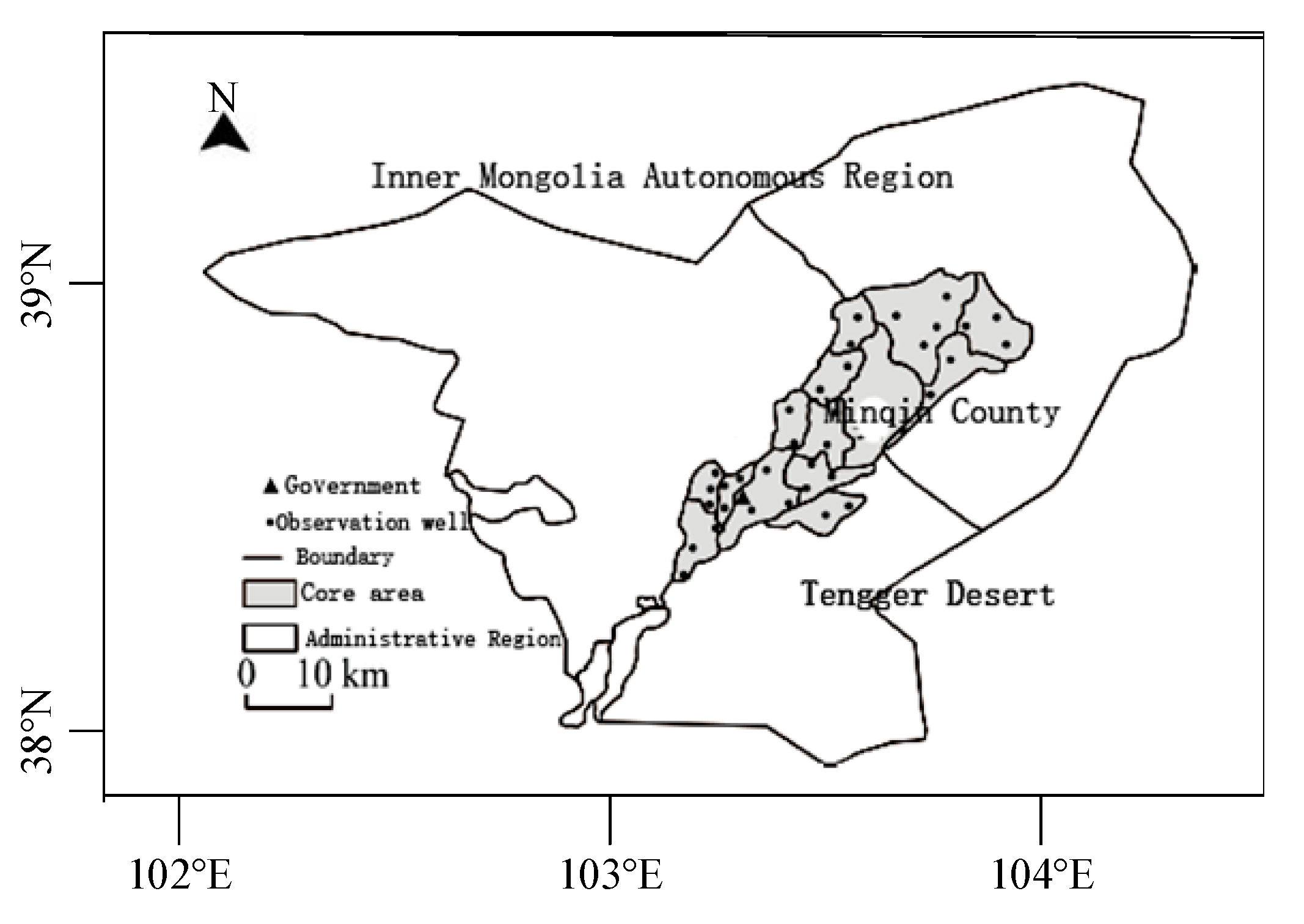

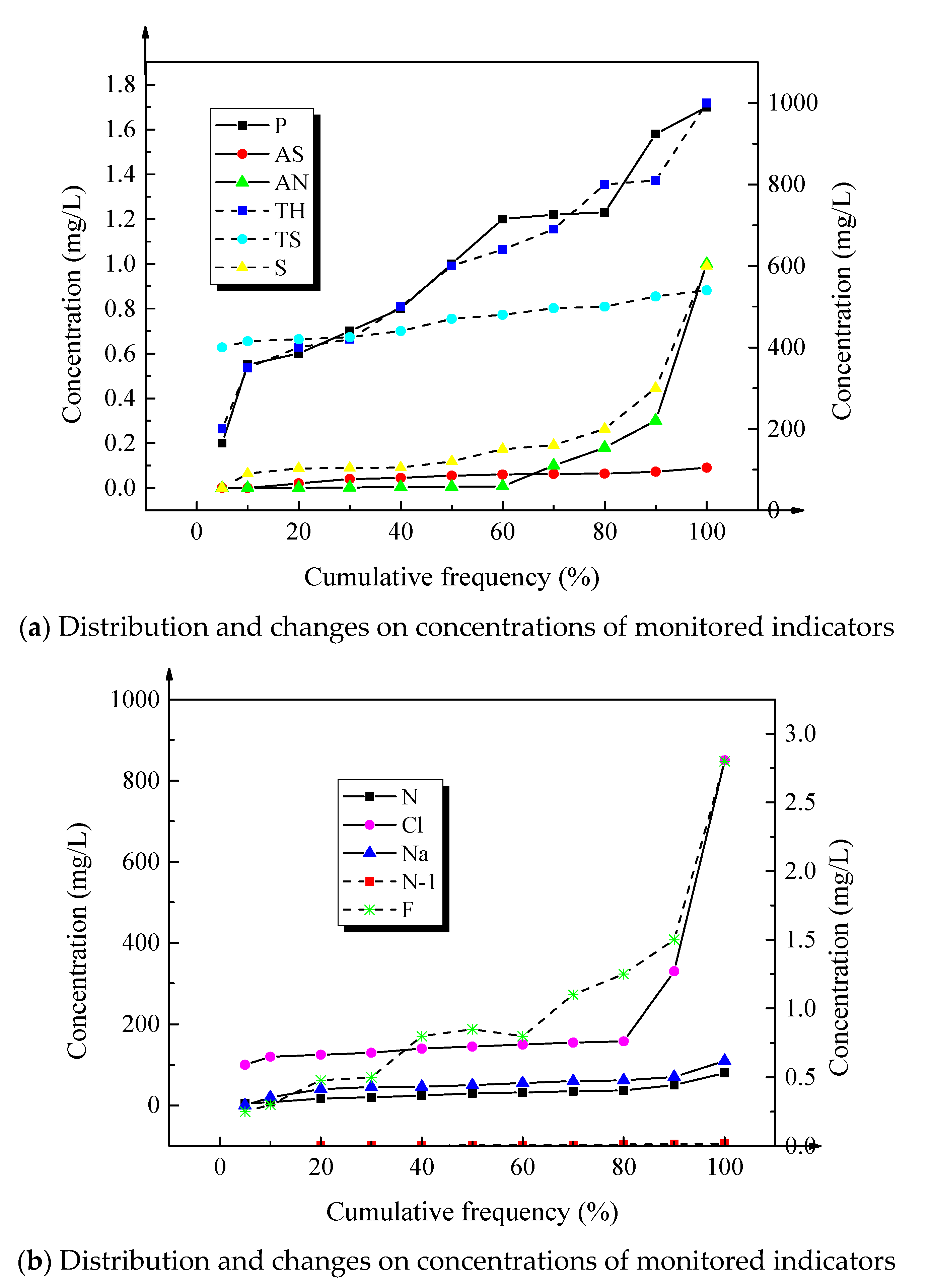
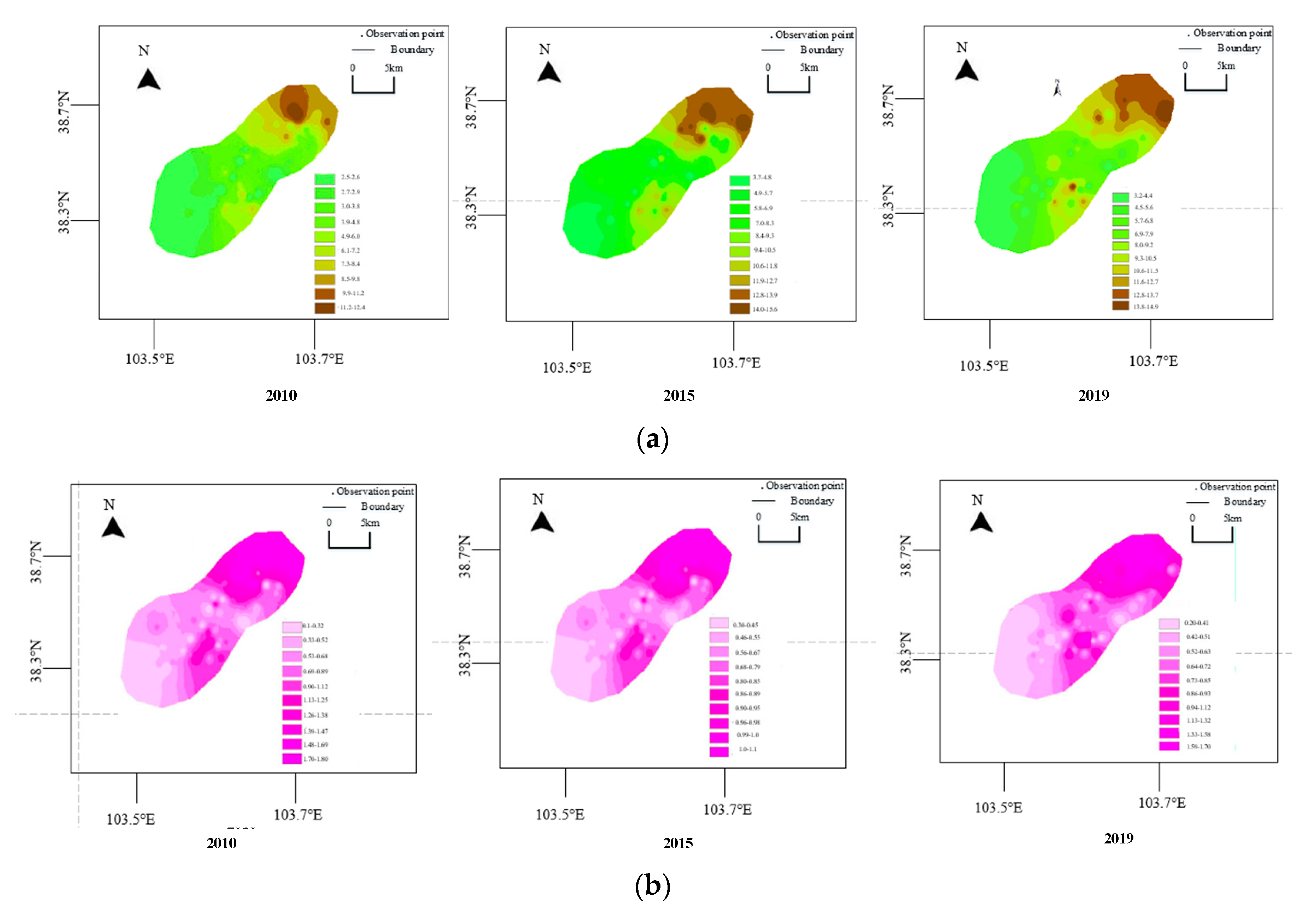
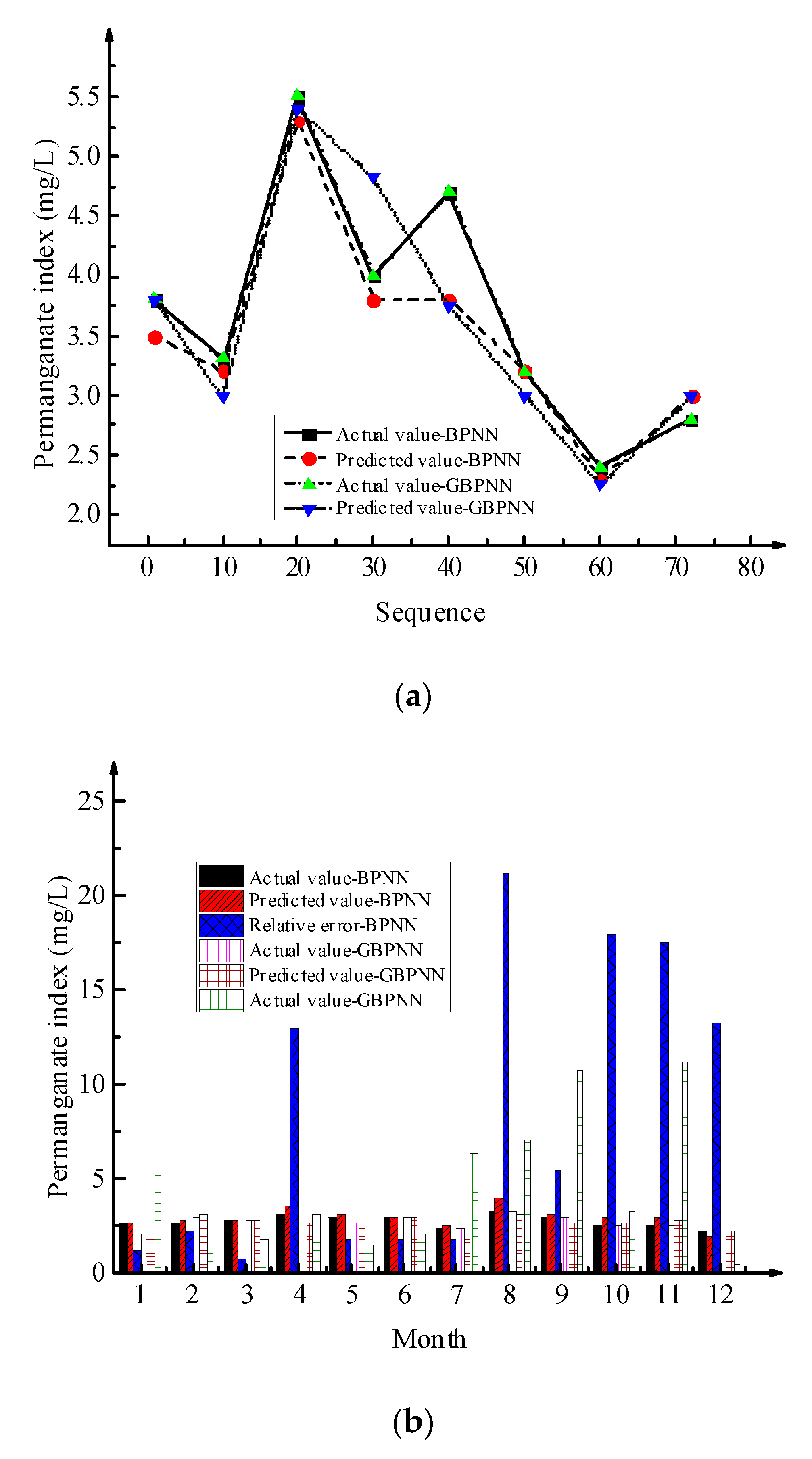
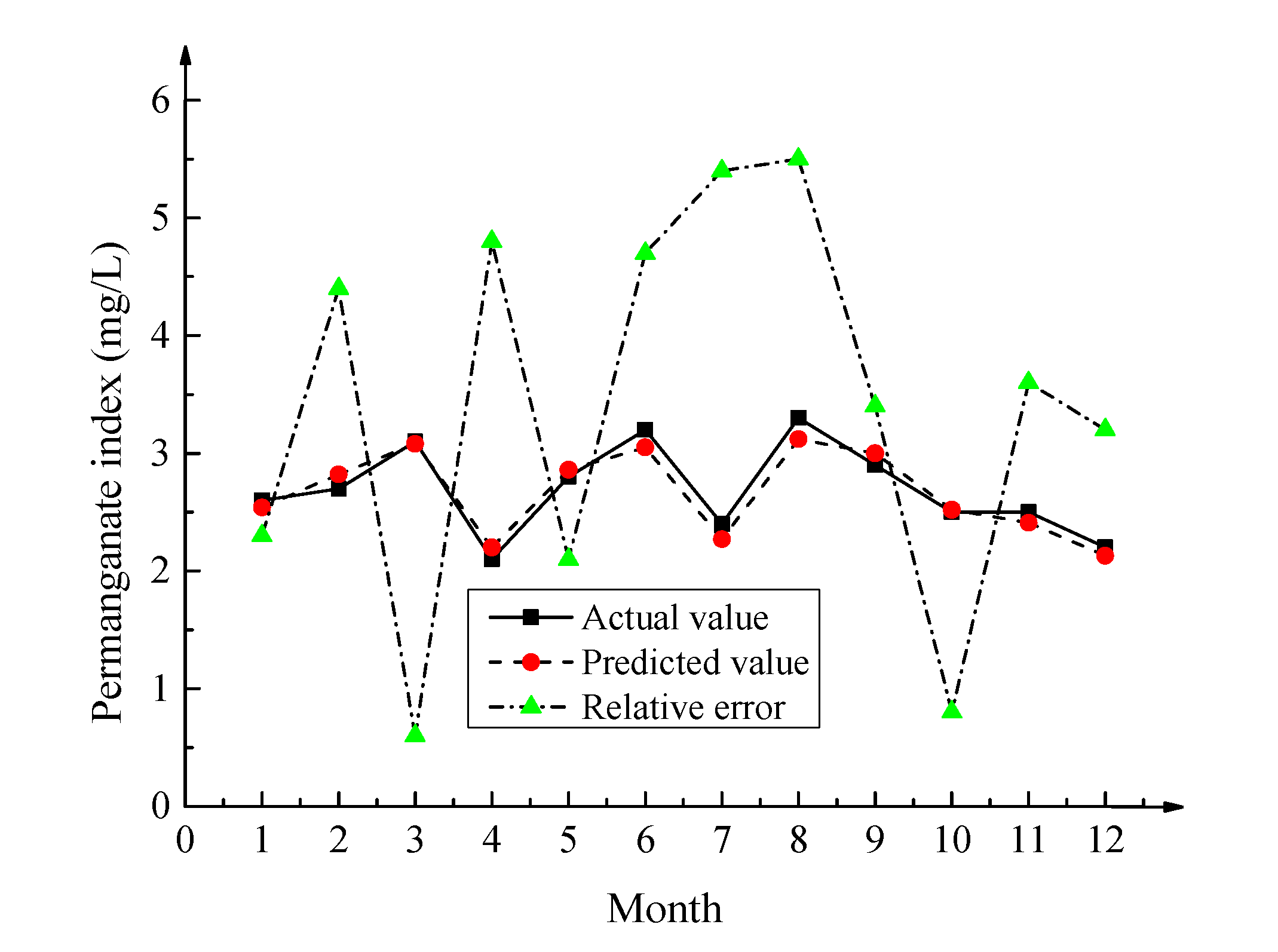
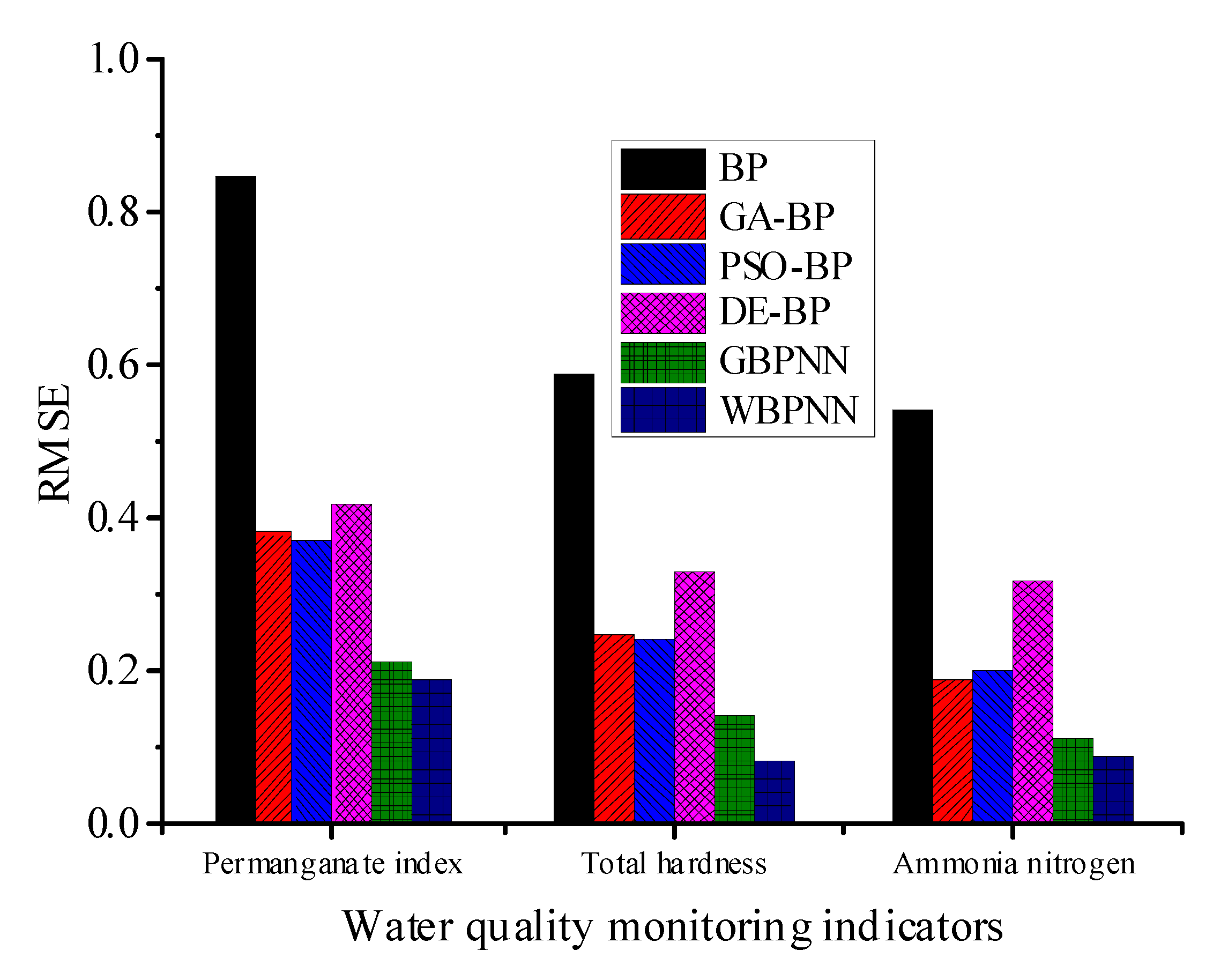
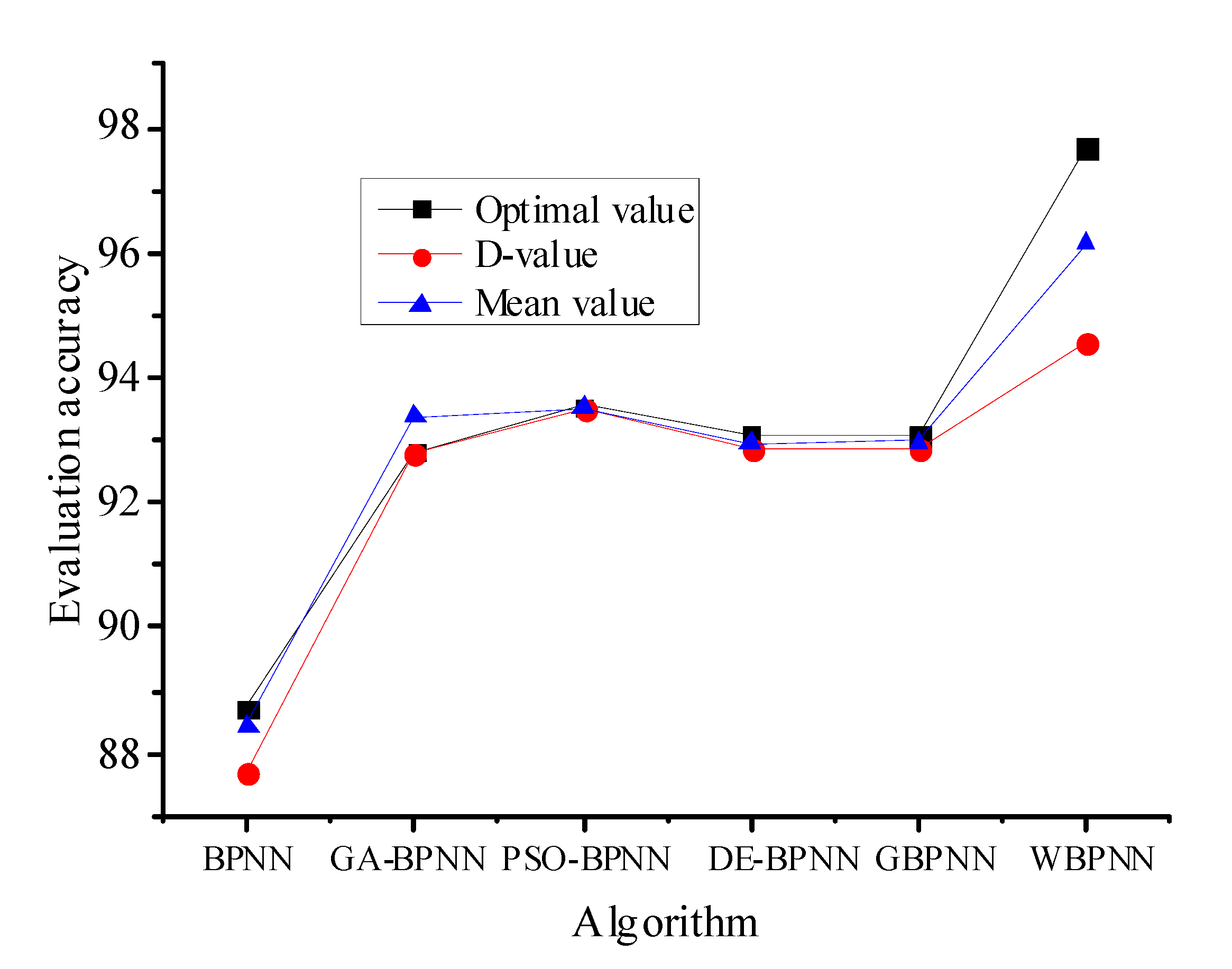

| Chemical Element | Maximal | Minimal | Mean | Standard Deviation | Variable Coefficient |
|---|---|---|---|---|---|
| Permanganate | 12.4 (2010) | 2.5 (2010) | 7.5 (2010) | 2.94 (2010) | 1.44 (2010) |
| 15.6 (2015) | 3.7 (2010) | 9.7 (2015) | 1.88 (2015) | 1.51 (2015) | |
| 14.9 (2019) | 3.2 (2019) | 9.1(2019) | 1.55 (2019) | 0.99 (2019) | |
| Ammonia nitrogen | 1.8 (2010) | 0.1 (2010) | 0.9 (2010) | 2.38 (2010) | 1.72 (2010) |
| 1.1 (2015) | 0.3 (2015) | 0.7 (2015) | 2.72 (2015) | 0.99 (2015) | |
| 1.7 (2019) | 0.2 (2019) | 0.9 (2019) | 2.59 (2019) | 1.22 (2019) | |
| SO42- | 3146.2 (2010) | 205.6 (2010) | 979.5 (2010) | 796.3 (2010) | 0.82 (2010) |
| 2253.1(2015) | 85.6 (2015) | 907.9 (2015) | 700.6 (2015) | 0.78 (2015) | |
| 2118.2 (2019) | 102.9 (2019) | 792.2 (2019) | 674.4 (2019) | 0.86 (2019) | |
| Total hardness | 5126.4 (2010) | 227.9 (2010) | 1082.4 (2010) | 70.2 (2010) | 1.16 (2010) |
| 1973.2 (2015) | 152.2 (2015) | 922.2 (2015) | 605.5 (2015) | 1.37 (2015) | |
| 2087.1 (2019) | 156.2 (2019) | 779.9 (2019) | 583.6 (2019) | 0.76 (2019) | |
| Ca2+ | 304.5 (2010) | 36.8 (2010) | 144.6 (2010) | 90.5 (2010) | 0.64 (2010) |
| 279.7 (2015) | 29.8 (2015) | 144.3 (2015) | 80.9 (2015) | 0.57 (2015) | |
| 346.8 (2019) | 6.5 (2019) | 115.6 (2019) | 85.7 (2019) | 0.75 (2019) | |
| Mg2+ | 495.8 (2010) | 32.6 (2010) | 135.4 (2010) | 125.5 (2010) | 0.94 (2010) |
| 330.6 (2015) | 19.1 (2015) | 136.5 (2015) | 107.3 (2015) | 0.78 (2015) | |
| 336.9 (2019) | 7.5 (2019) | 108.4 (2019) | 109.6 (2019) | 1.02 (2019) | |
| Na+ and K+ | 953.7 (2010) | 54.8 (2010) | 394.3 (2010) | 275.2 (2020) | 0.71 (2010) |
| 856.6 (2015) | 44.5 (2015) | 383.8 (2015) | 290.5 (2015) | 0.77 (2015) | |
| 918.2 (2019) | 20.7 (2019) | 356.9 (2019) | 326.8 (2019) | 0.93 (2019) | |
| Nitrate | 1.7 (2010) | 0.01 (2010) | 0.13 (2010) | 0.5 (2010) | 0.75 (2010) |
| 78.2 (2015) | 0.6 (2015) | 19.58 (2015) | 24.1 (2015) | 0.24 (2015) | |
| 95.9 (2019) | 0.0 (2019) | 0.03 (2019) | 0.3 (2019) | 0.62 (2019) |
| Indicator | I. | II. | III. | IV. | V. |
|---|---|---|---|---|---|
| Permanganate | 0–2.0 | 2.0–4.0 | 4.0–6.0 | 6.0–10.0 | 10.0–15.0 |
| Total hardness | 0–150 | 150–300 | 300–450 | 450–550 | >550 |
| Ammonia nitrogen | 0–0.15 | 0.15–0.50 | 0.50–1.0 | 1.0–1.5 | 1.5–2.0 |
| Observation Well | Predicted Water Quality Level | ||||||||
|---|---|---|---|---|---|---|---|---|---|
| 2010 | 2015 | 2019 | |||||||
| PI | TH | AN | PI | TH | AN | PI | TH | AN | |
| 176 | IV | V | III | V | IV | III | IV | V | III |
| 167 | IV | V | III | IV | V | III | IV | V | III |
| 159 | IV | V | III | IV | V | IV | III | V | II |
| 142 | V | V | IV | IV | V | III | IV | V | III |
| 132 | IV | IV | IV | V | III | III | IV | IV | IV |
| 112 | V | V | III | IV | V | III | IV | V | III |
Publisher’s Note: MDPI stays neutral with regard to jurisdictional claims in published maps and institutional affiliations. |
© 2020 by the authors. Licensee MDPI, Basel, Switzerland. This article is an open access article distributed under the terms and conditions of the Creative Commons Attribution (CC BY) license (http://creativecommons.org/licenses/by/4.0/).
Share and Cite
Sun, J.; Wang, G. Geographic Information System Technology Combined with Back Propagation Neural Network in Groundwater Quality Monitoring. ISPRS Int. J. Geo-Inf. 2020, 9, 736. https://doi.org/10.3390/ijgi9120736
Sun J, Wang G. Geographic Information System Technology Combined with Back Propagation Neural Network in Groundwater Quality Monitoring. ISPRS International Journal of Geo-Information. 2020; 9(12):736. https://doi.org/10.3390/ijgi9120736
Chicago/Turabian StyleSun, Jing, and Genhou Wang. 2020. "Geographic Information System Technology Combined with Back Propagation Neural Network in Groundwater Quality Monitoring" ISPRS International Journal of Geo-Information 9, no. 12: 736. https://doi.org/10.3390/ijgi9120736




